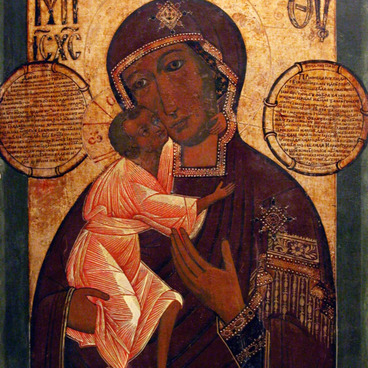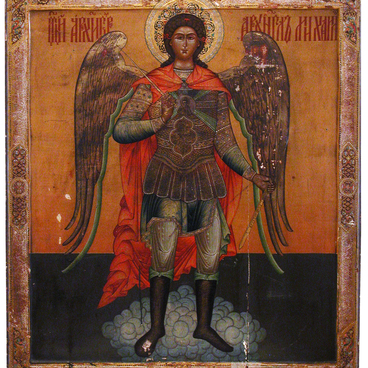The icon Abalakskaya Mother of God is a copy of a wonderworking icon from the Abalaksky Znamensky Monastery. Abalaksky image of Mother of God is one of the most venerated ones in the Siberia.
Iconography of the image comes from iconographic type Our Lady of the Sign, or Oranta. It is one of the general types of Mother Mary’s iconography. Her hands are spread in the orans position and the palms are open in gesture of intercessory prayer. Upon her breast is the image of a Divine baby, yet unborn Child Jesus, depicted within a round aureole. The Russian title of an icon Znamenie was first mentioned in the annals Tale about the Fight Between the Citizens of Novgorod and Suzdal (1169). “The znamenie was given and a wonderful miracle took place from the icon of Saint Mother of God in Novgorod”. Since then the term “znamenie” was used for such iconographical type.
The original Abalakskaya Mother of God icon was created in 1637 during the time of Tobolsk archbishop Nektary. A wonderful acquisition of the icon took place thanks to the widow named Maria, who lived at Abalaksky churchyard 30 km away from Tobolsk. The woman often saw the visions, where Our Lady of the Sign, Mary of Egypt, and Saint Nicholas visited her. Maria told a priest about it, and he started construction of the Znamenskaya church. In 1636 he commissioned the painting of an icon with three mentioned saints. It was believed that prayer in front of this icon gave people relief and healing. Many various copies of this image, also believed to be wonderworking, were made. One of them is an Abalakskaya-Semipalatinskaya wonderworking icon. Abalaksky Znamensky Monastery was founded by Catherine the Great in honour of this icon. Icon from the collection of the Kurgan museum is a copy of the one previously featured in the monastery and lost after the revolution in 1919.
The main difference of Abalakskaya Mother of God is that it has images of Mary of Egypt and Saint Nicholas on its edges. On Mother Mary’s head is a piece of cloth with imitation of pearl, a diadem with elements of floral ornament, cherubim, and figured contour. The ornament on the diadem and on the edges imitate the ornament of icon frame it used to be covered with in the mid-to-late 19th century, when the icon was painted.
Iconography of the image comes from iconographic type Our Lady of the Sign, or Oranta. It is one of the general types of Mother Mary’s iconography. Her hands are spread in the orans position and the palms are open in gesture of intercessory prayer. Upon her breast is the image of a Divine baby, yet unborn Child Jesus, depicted within a round aureole. The Russian title of an icon Znamenie was first mentioned in the annals Tale about the Fight Between the Citizens of Novgorod and Suzdal (1169). “The znamenie was given and a wonderful miracle took place from the icon of Saint Mother of God in Novgorod”. Since then the term “znamenie” was used for such iconographical type.
The original Abalakskaya Mother of God icon was created in 1637 during the time of Tobolsk archbishop Nektary. A wonderful acquisition of the icon took place thanks to the widow named Maria, who lived at Abalaksky churchyard 30 km away from Tobolsk. The woman often saw the visions, where Our Lady of the Sign, Mary of Egypt, and Saint Nicholas visited her. Maria told a priest about it, and he started construction of the Znamenskaya church. In 1636 he commissioned the painting of an icon with three mentioned saints. It was believed that prayer in front of this icon gave people relief and healing. Many various copies of this image, also believed to be wonderworking, were made. One of them is an Abalakskaya-Semipalatinskaya wonderworking icon. Abalaksky Znamensky Monastery was founded by Catherine the Great in honour of this icon. Icon from the collection of the Kurgan museum is a copy of the one previously featured in the monastery and lost after the revolution in 1919.
The main difference of Abalakskaya Mother of God is that it has images of Mary of Egypt and Saint Nicholas on its edges. On Mother Mary’s head is a piece of cloth with imitation of pearl, a diadem with elements of floral ornament, cherubim, and figured contour. The ornament on the diadem and on the edges imitate the ornament of icon frame it used to be covered with in the mid-to-late 19th century, when the icon was painted.

